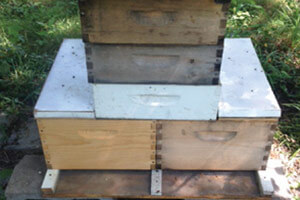
There have been a few inquiries regarding two-queen systems since my last article. There are several methods of making a two-queen colony. Some others may be more productive than the horizontal method to which I am committed. Most two-queen systems have extracted honey production as a goal. Double-queen systems date back many years. Farrar reported in 1958 that less equipment is required to produce a crop of honey with two queens in a hive than with one queen in a hive. Farrar made 12-frame boxes in a medium depth for brood chambers and hive bodies. Peer proved that significantly less time, equipment and cost were required to produce a pound of honey using two queens than with single-queen colonies. Walton of New Zealand found that double-queen systems consistently produced from 60 – 75 percent more honey than single-queen systems. Floyd Moeller at the bee research lab in Madison, Wisconsin exhibited an average yield increase of 112 pounds with double queen colonies over single queen colonies during a 6 year study from 1967 – 1974.
It is not only possible but probable that a two-queen colony will produce more honey than a single-queen colony. Moeller favored the medium-depth hive boxes for both supers and hive bodies. This system would require four hive bodies and 6 – 7 supers for extraction. His colonies were stacked in a vertical orientation. One brood chamber on the bottom with a middle brood chamber and then a second queen in a brood chamber on top formed a three-story hive at the start. Moeller used auger holes drilled in the top story for the bees to enter and exit. He does suggest that this upper entrance be closed with screen so that bees in the upper room get accustomed to using the bottom entrance. He also suggested reversing the brood chambers to facilitate faster build up. These two-queen hives were loaded two months before the honey flow. They were fed syrup and pollen substitute. He often split a strong hive early, placing a new queen in the top position. Today we know that a queen excluder can be used to separate the queens adequately. Moeller screened the queens from one another, opening the upper entrance hole for the upper story bees. He would eventually remove the screens as the supers went on. The queens would eventually meet and one would kill the other. This process evidently did not happen quickly so that the two queens might continue laying eggs for several weeks before the colony had a single queen. The population of such a colony could easily exceed 60,000 bees and more probably 90,000. The result would be 6 or 7 supers of honey and maybe even more using medium depth boxes.
Another vertical system was developed using three standard Langstroth hive bodies. This system involved a divider board. That is a thin piece of plywood that goes from the top of the brood chamber to the bottom. This board must be queen tight from hive cover to the bottom board. It is the system I tried back in the years between 1982 and 1984. The colony produced an abundant honey crop. However, manipulation was difficult. One side died in 1984 so I removed the divider board and made a single colony that was less productive but easier to manage. In 1983 that divided double queen colony made 200 pounds of extracted honey. Most beekeepers who have tried to keep bees in a double queen system have abandoned the idea because single colonies are easier to manage. Six standard hive bodies full of honey above or between 4 hive bodies of brood is 100 inches or more than 8 feet of hive. If you add a hive stand there is 9 feet of height. Hence the discussions often include needing a ladder to work such a colony. An upper entrance will always be needed for drones to enter and exit.
Simplest Two-Queen System
The simplest version of a vertical two-queen system that I know of is to place a queen excluder between the two brood boxes and put a queen in the box without eggs about 3 days later. These two queens raised with a double screen between them will work together for awhile after the double screen is removed and the two colonies are combined using a sheet of newspaper the same way we combine a weak hive with another. The combination is done once the main honey flow has started. This vertical system is simpler, but you still wind up with an 8 foot tall hive that requires a ladder to super the bees!
The system that I tried last year uses …


